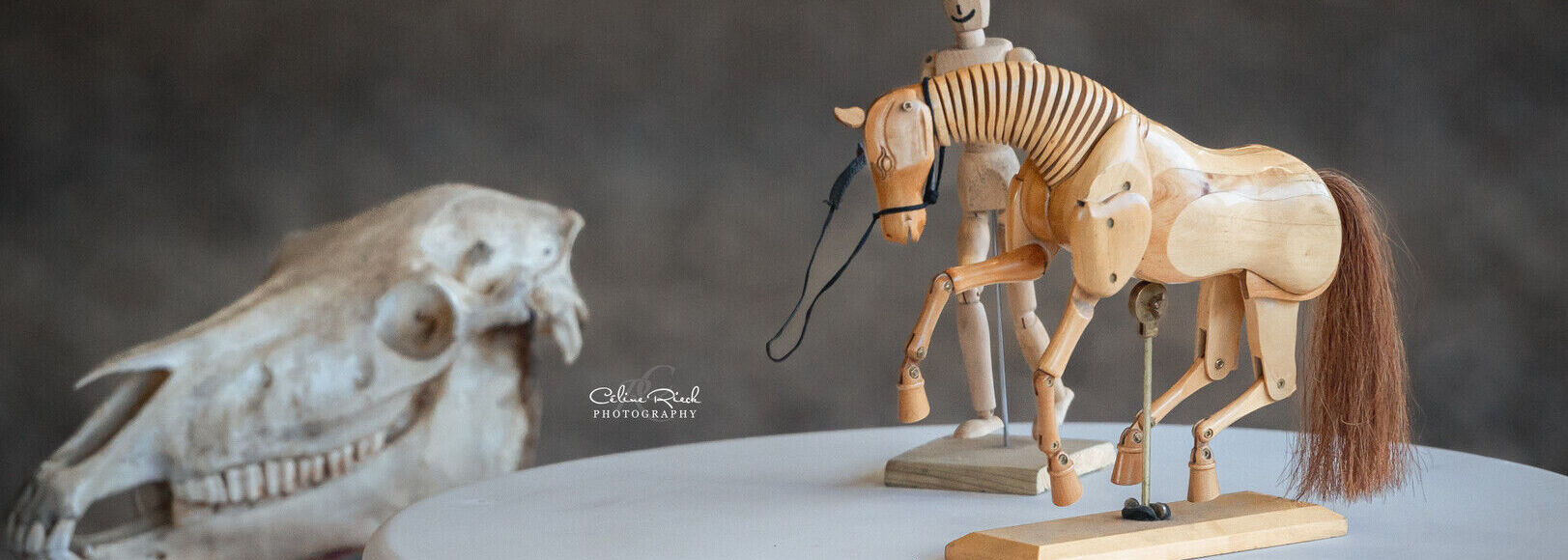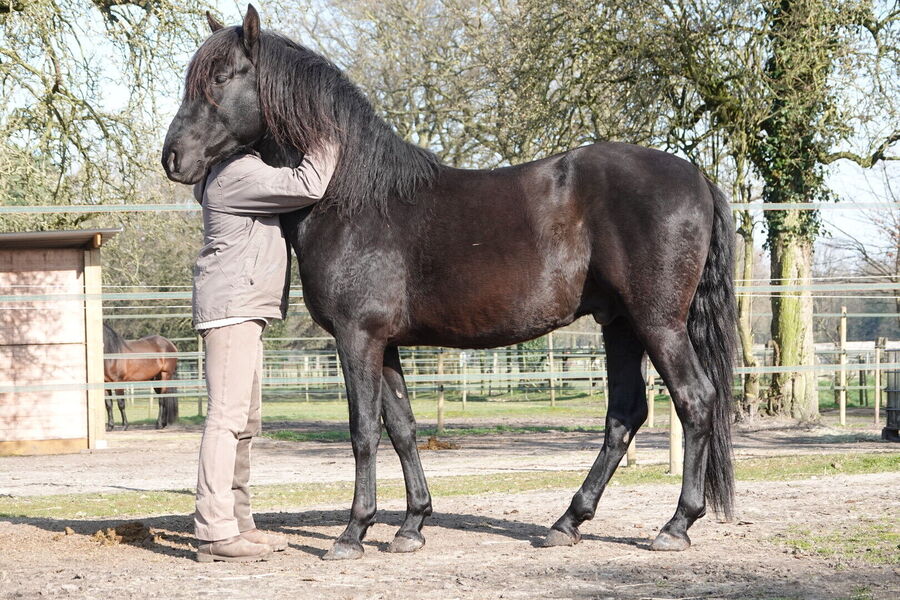The structure of the Bitless Art of Riding (BAR) was developed by Jossy Reynvoet.
This academy is a collection of over 50 years spent with horses, from playing cowboys and Indians with my father's ponies as a child, to show jumping (25 years), horsemanship (15 years) and finally the Academic Art of Riding (since 2009).
Since 1993, bitless riding has been a conscious choice. Partly out of respect for the horse and partly because I see it as an extra challenge to achieve the highest level of equitation with lightness and harmony. The aim of the BAR structure is to develop the horse's natural skills and strengths without the use of a bit, so that the horse can show its true abilities. Togetherness, clarity of communication, gymnastics and increased awareness in everything we do on the way to collection are all part of this. I have developed a gradual, logical and systematic structure that allows everyone to progress in their own way. For me, equitation is about mastering everything that makes a horse happy and a complete riding horse. This is what we show in words and pictures in this academy. We hope you enjoy learning!
The BAR structure is divided into three main categories: fundamental education, basic education and physical education.
It is an "educational system" that takes into account the age and natural abilities of a horse in the "ideal situation". By ideal, I mean that the horse grows up with humans for the first five years, but also in a herd where it learns submissiveness and togetherness from other older horses. This is important for any horse, but especially for stallions. Not everyone comes into contact with a horse that has been reared in an ideal situation. Often we fall in love with horses that already have a past that we know little or nothing about, but here too you can use the BAR structure. It can only benefit you and your horse in your growth process, emotionally, mentally and physically.

A word of explanation.
In the FUNDAMENTAL class the focus is mainly emotional (relational). Everything takes place on a partner level. Similar to a child growing up with its parents in the first years of life and then going to kindergarten. The horse is given the freedom to learn gradually and playfully. In other words, things are literally taught in freedom, such as brushing, giving hoofs, halter training, etc.
From birth, the young horse receives most of its love and enthusiasm from humans. The better your relationship, the stronger and more confident both horse and human will feel. In this class we will ensure that the horse learns to trust you, to be at peace with you, to look at you, to be interested in you and to respect your space. It is not easy for a flight animal to look at a predator with trust and not run away. This is all the more reason to pay special attention to a healthy relationship in the beginning. As humans, we scan with our eyes, our hands are always ready to do things that make a horse want to flee. In the fundamental class we learn to use our bodies, eyes and limbs differently, to be more aware of our movements, so that the horse becomes interested in us, trusts us and wants to be with us. You learn not to act like a predator. You learn to come down.
Your relationship, based on trust and respect, is essential and will remain the most important element throughout the rest of the education. This will ensure that your horse remains relaxed, enthusiastic and focused. As your relationship improves, your horse will give you control even without a bit in its mouth. A good bond is a must.

The BASIC class represents the mental part. Your horse will now gradually get to know you as a coach. Ideally you should start when your horse is 3.5 years old. Your horse is ready to learn. In the fundamental class it has built up trust in you and you in your horse, there is respect for each other. It is ready to gradually increase its concentration. The horse is ready to take in other learning material; there is peace in his head and confidence. The horse is gradually becoming familiar with visual and physical aids; different leading positions, secondary aids, basic hand work. You expose it to traffic, the woods, the trailer, the saddle, you encourage it and show it more and more new things, because that's what a coach does. With the emphasis on " showing ".
The horse gradually learns to progress within a logical and systematic structure through different techniques. One of these techniques is to gradually teach the horse to control itself in stressful situations and not immediately resort to its flight reflex. The horse learns to control its body with its mind. It no longer reacts as a flight animal. As a result, your horse continues to think with you to overcome difficult situations together and come out stronger. Problematic situations do not disappear, but they become challenges once you have mastered this technique. If you want to do everything with your horse, it is important to take it outside, into nature, and not just work in an indoor and/or outdoor arena. This will result in significant mental growth for the horse.
In this way we can gradually build up the ability to concentrate and think. The greater the ability to concentrate, the quicker we will achieve lightness and relaxation without losing the horse's enthusiasm.

The PHYSICAL class aims to make the horse more supple and stronger in body and limbs, giving it more pride and charisma. Not only in the eyes of humans, but also in the company of other horses.
You should compare this to a young adult who chooses to go to sports school with the ambition of becoming a strong athlete. The only difference for a horse is that it does not choose to become an athlete. All the more reason for us to take responsibility for the horse's gradual and systematic preparation. At 4.5 years of age, the horse is ready to start carefully learning the first lateral and diagonal aids. The horse now comes to know you as the trainer who will systematically offer exercises to make the horse more supple and stronger so that it can carry you into older age. In this class we also start with "First Riding" when the horse is around 5.5yrs old and "Basic Riding" when the horse is +/-6.5yrs old.
From the age of +/-7.5 years you will start with "Gymnastic Riding" and more and more collected ground work, lunging and hand work. Once you have reached this stage in your development, you will feel that your horse offers better collection on its own. You will see your horse become more beautiful and stronger.
He is now about 8.5 years old and you have prepared him step by step for the final part of the more advanced work of collection. Your horse will now be able to ride longer distances in the countryside.
We work on vertical and horizontal balance. We develop a muscular topline. The horse becomes more beautiful, stronger, elegant and proud.
It is important to understand that a horse needs training and time to move with lightness and harmony. A horse ridden bitless will tell you when it is ready to carry a rider. Listen to your horse. If you work systematically, you will feel and see when the horse is ready for the next step in its development towards the blissful feeling of "Collected Riding in Freedom".
True lightness arises when the horse has the possibility to offer this to you with a free head, otherwise it is false lightness.

Note
It is not possible to see the three learning classes as completely separate from each other, e.g. you also show love and enthusiasm in the basic and physical classes. The order of the 3 classes is important: first connection, then concentration and then physical challenge. There are different elements in each class. These elements flow into each other and complement each other, but you don't necessarily have to use them in the order I have written them down, especially if your horse has not been reared in an ideal situation.
If you feel that you are not progressing in your development, take a step back and go back to the basics with your horse and you will find that taking these steps back into the structure will give your horse energy and confidence again. And you will have the time to be inspired and to self-reflect.
Those who feel inferior because they have to work on the basics have not understood the art of the equestrian world and will never understand it until they have a change of perspective!
Good development is not linear. It involves trial and error, bouncing back and growing again.
Basic is a foundation for advanced work later on. But it also works the other way round, if you get stuck in the advanced work you go back to the base. That's why the foundation is there. It is not something you stop once you have gone through it. You need the basics and the fundamentals every day as much as you need the physical. The important thing to realize is that it is impossible to balance a horse if you only focus on the physical.
Jossy Reynvoet


